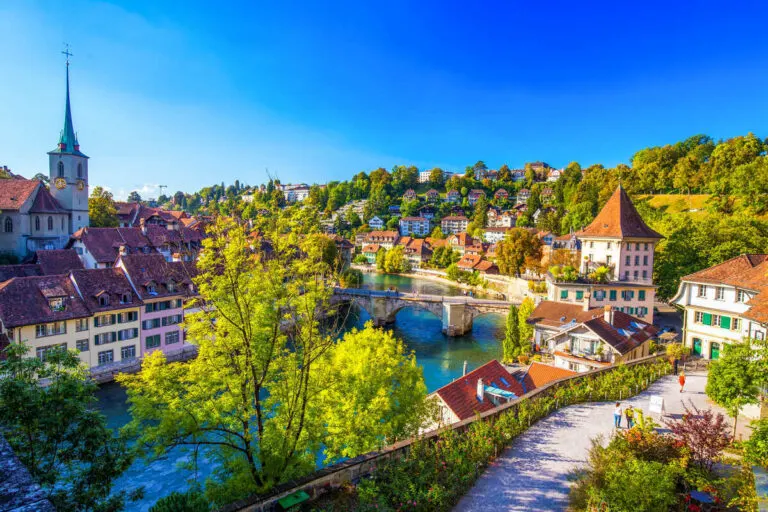With the war that continues to rage in Ukraine, rising crime, illegal immigration and the threat of extremism now back to haunt numerous European countries, it’s only natural that travelers would be concerned about their safety crossing the pond.
Europe remains a safe destination at large, but there’s no denying that major cities like London, Paris, and Berlin have been facing significant security threats lately, with all the polarizing marches that have taken place lately and security forces currently on high alert.
Thankfully, these 5 other cultural hotspots have enjoyed a higher level of stability and according to CEO World Magazine, are some of the safest in the world:
How Were These Cities Ranked?

Before we get into the destinations in question, let’s take a quick look at the methodology of this research: CEO World staff have ranked over 300 global cities based on low crime rates, security measures, and stable governments, with a decreasing safety score between 100 and 0.
Abu Dhabi, the safest city in the world, was attributed a score of 97.73, while Chicago in the United States is the least-safe in the top 300, scoring 53.49; in Europe, five cities stood out as safest, featuring inside the top 15 with near-identifcal, approximate scores of 96.
According to the organization, they are the continent’s least-risky when it comes to tourism, being safe urban areas visitors can explore, and take in the culture ‘with peace of mind’, knowing they’re unlikely to be affected by crime, or get caught up amid civil unrest.
Without further ado, these are the European winners:
Ljubljana, Slovenia

The capital and leading tourist destination in Slovenia, a lesser-known country in Central-Eastern Europe that Americans would recognize as having spawned former First Lady Melania Trump, Ljubljana ticks all the boxes for what makes a European getaway great:
As a medieval city, it’s got the cultural appeal with cobbled streets, terracotta-roofed houses, pointy church spires and a fairytale, hilltop castle to its name; it’s an underrated foodie spot, and it’s also much more peaceful, as the France and Italy crowds—and pickpockets— are nowhere to be seen.
Day or night, tourists just never feel on edge in Ljubljana, whether they’re walking around and admiring the gorgeous Baroque cityscape, or enjoying dinner in an al fresco by the banks of the scenic Ljubljanica River: it is so quaint, and crime-free, it barely feels like a capital.
Trondheim, Norway

Forget Oslo or Bergen: the safest city in one of Europe’s safest countries is Trondheim, an overlooked coastal port on a fjord, easily distinguished by its picturesque waterfront, lined by colorful timber buildings and historic canals.
As it is largely rural, Norway as a whole is pretty tranquil, in general, yet there’ll always be the occasional knife attack in the capital, or an increase in radicalized groups across larger urban centers: not in Trondheim, where violent crime is non-existent.
Other than featuring among the least-dangerous cities in the world statistically, we can’t fathom why there aren’t more tourists coming when it’s home to a landmark 11th-century cathedral, the imposing Kristiansten Fortress and its fjord-side location offers access to stunning natural sites.
Munich, Germany

At number three, we have Munich, the cultural heart of the German state (and historic region) of Bavaria, and a sprawling metropolis you’d expect to be rife with banditry, considering it’s a magnet for tourism and Germany’s third largest conurbation.
Surprisingly enough, Munich is a very chill place, with very low rates of robbery reported across touristy zones, including the 12th century Marienplatz, where visitors spend most of their time in (try and visit Berlin’s Pariser Platz without being approached by the odd scammer).
Even during Oktoberfest, the iconic Bavarian celebration, streets remain largely crime and disruption-free, and though we wouldn’t recommend you let your guard down in any big city, particularly in the nighttime, it’s highly unlikely you’ll get mugged off in Munich.
Bern, Switzerland

Believe it or not, Switzerland has no official capital, but it’s widely accepted that the charming Bern, a compact, walkable medieval city home to just over 100,000 inhabitants, full of UNESCO-listed buildings and famous for its 13th-century Zytglogge clock, is the capital de facto.
It will only take you a day or two to tick off all the main landmarks in Bern, though we’d advise you to prolong your stay, as it’s the unofficial gateway to the Swiss Alps, with a number of scenic train routes departing form the main station.
Needless to say, Zurich and Geneva’s small sister is far more tranquil, with less traffic pollution, fewer men in suits pacing up and down the high street, bigger, more verdant, more majestic pond-dotted city parks, and none of the ‘big city problems’.
The Hague, Netherlands

The safest city in Europe according to CEO World, The Hague is a canal city and the administrative capital of the Netherlands, and in a way, a more grown up, ‘sober’ version of Amsterdam: you know, no Red Light District, no stench of weed, and certainly no raucous youth doing the rounds.
The Hague is most commonly associated with its international institutions, most notably the International Court of Justice and imperial palaces—the Dutch royal family’s official residence is here, at Huis ten Bosch— but it shouldn’t be so easily discounted as a cultural hub:
The medieval Binnenhof is perfectly well-preserved, with canal-front fortifications dating back to the 13th century, and the unique mix of modernist and traditional Mannerist architecture is a striking sight; plus, it’s far less crowded and arguably better surveilled than Amsterdam.
Credit: Source link

